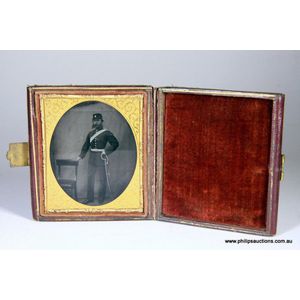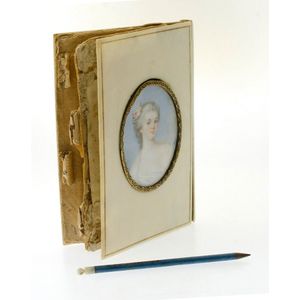Gentleman's Daguerreotype Set with Cased Leather
You must be a subscriber, and be logged in to view price and dealer details.
Subscribe Now to view actual auction price for this item
When you subscribe, you have the option of setting the currency in which to display prices to $Au, $US, $NZ or Stg.
- Sinister - The words dexter and sinister are commonly used in heraldry, but have a more general application in the world of antiques and collectables (mainly sculpture and numismatics) to describe the position of the head of the subject. Dexter, which is Latin for right means the subject is looking to their right, while sinister, which is Latin for left, means the subject is looking to their left.
- Daguerreotype - The first photographic image was achieved in 1814 by Frenchman Joseph Niepce, with first photographic with the camera obscura, an optical device that projects an image onto a screen. However, the image required eight hours of light exposure and later faded.
Joseph Niepce continued working on improving his invention Louis-Jacques-Mandé Daguerre, an artist. Niepce died in 1833, but Daguerre carried on, and at a meeting of the French Academy of Sciences in Paris on August 19, 1839 announced he had discovered a new method of photography, the daguerreotype which he named after himself. The daguerreotype process reduced the exposure time from 8 hours to 3 - 15 minutes.
In major cities, professional photographers of the time, known as daguerreotypists, invited celebrities and political figures to their studios, hoping that by displaying a selection of portraits in their windows, the public would be encouraged to be photographed.
However the popularity of the daguerreotype was short-lived, and its use declined in the late 1850s when the ambrotype, a faster and less expensive photographic process, became available. However the ambrotype still required the services of a professional photographer and it was not until the invention of Kodak's Box Brownie in 1900 that the public were able to shoot their own photographs.
Due to the short time (20 years) that the daguerreotype was popular, and the fact that the image was produced directly onto the plate, meaning there were no negatives, original daguerreotypes are scarce. Most daguerreotypes are portraits, with landscapes and street scenes being less less common.
This item has been included into following indexes:
Visually similar items

A fine antique cased Daguerrotype of a soldier, circa 1860, the image of a solider in a single breasted frock coat with sword, beneath a decorative pinchbeck mat with preserver, deep amber velvet to the opposite face, and housed in a tooled deep brown leat

Two antique framed silhouettes with hand written information verso, 20 cm x 15 cm approx (frames)

Circa 19th century portrait miniature on ivory. Oval portrait of a young woman set within the cover of an ivory notebook. Height 10 cm, (total)

Royal Worcester plaque by Harry Ayrton painted with robins feeding their young, signed lower right & set in a gilt frame. Condition poor, two large cracks, of frame 40 x 32 cm
